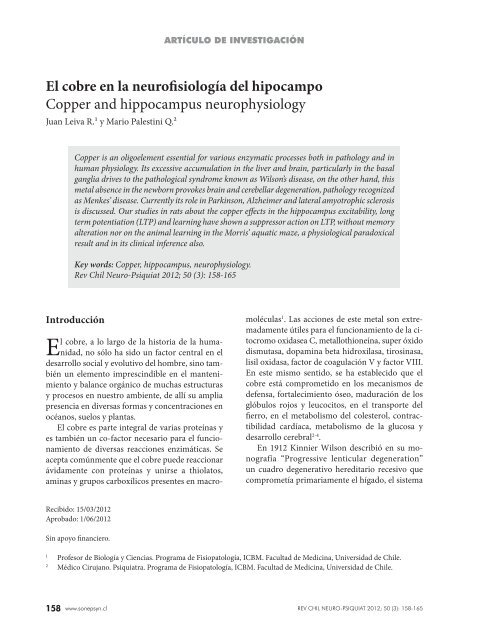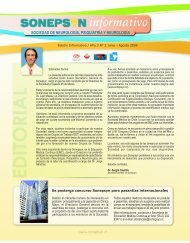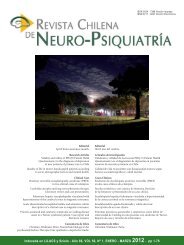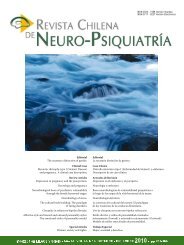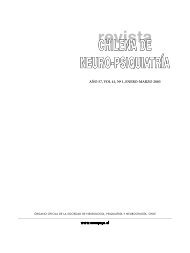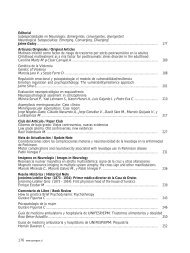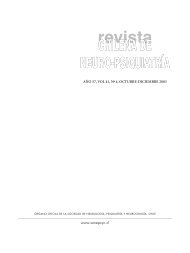Revista 3-2012 (PDF) - Sonepsyn
Revista 3-2012 (PDF) - Sonepsyn
Revista 3-2012 (PDF) - Sonepsyn
You also want an ePaper? Increase the reach of your titles
YUMPU automatically turns print PDFs into web optimized ePapers that Google loves.
artículo de investigación<br />
El cobre en la neurofisiología del hipocampo<br />
Copper and hippocampus neurophysiology<br />
Juan Leiva R.¹ y Mario Palestini Q.²<br />
Copper is an oligoelement essential for various enzymatic processes both in pathology and in<br />
human physiology. Its excessive accumulation in the liver and brain, particularly in the basal<br />
ganglia drives to the pathological syndrome known as Wilson’s disease, on the other hand, this<br />
metal absence in the newborn provokes brain and cerebellar degeneration, pathology recognized<br />
as Menkes’ disease. Currently its role in Parkinson, Alzheimer and lateral amyotrophic sclerosis<br />
is discussed. Our studies in rats about the copper effects in the hippocampus excitability, long<br />
term potentiation (LTP) and learning have shown a suppressor action on LTP, without memory<br />
alteration nor on the animal learning in the Morris’ aquatic maze, a physiological paradoxical<br />
result and in its clinical inference also.<br />
Key words: Copper, hippocampus, neurophysiology.<br />
Rev Chil Neuro-Psiquiat <strong>2012</strong>; 50 (3): 158-165<br />
Introducción<br />
El cobre, a lo largo de la historia de la humanidad,<br />
no sólo ha sido un factor central en el<br />
desarrollo social y evolutivo del hombre, sino también<br />
un elemento imprescindible en el mantenimiento<br />
y balance orgánico de muchas estructuras<br />
y procesos en nuestro ambiente, de allí su amplia<br />
presencia en diversas formas y concentraciones en<br />
océanos, suelos y plantas.<br />
El cobre es parte integral de varias proteínas y<br />
es también un co-factor necesario para el funcionamiento<br />
de diversas reacciones enzimáticas. Se<br />
acepta comúnmente que el cobre puede reaccionar<br />
ávidamente con proteínas y unirse a thiolatos,<br />
aminas y grupos carboxílicos presentes en macromoléculas<br />
1 . Las acciones de este metal son extremadamente<br />
útiles para el funcionamiento de la citocromo<br />
oxidasea C, metallothioneína, super óxido<br />
dismutasa, dopamina beta hidroxilasa, tirosinasa,<br />
lisil oxidasa, factor de coagulación V y factor VIII.<br />
En este mismo sentido, se ha establecido que el<br />
cobre está comprometido en los mecanismos de<br />
defensa, fortalecimiento óseo, maduración de los<br />
glóbulos rojos y leucocitos, en el transporte del<br />
fierro, en el metabolismo del colesterol, contractibilidad<br />
cardíaca, metabolismo de la glucosa y<br />
desarrollo cerebral 2-4 .<br />
En 1912 Kinnier Wilson describió en su monografía<br />
“Progressive lenticular degeneration”<br />
un cuadro degenerativo hereditario recesivo que<br />
comprometía primariamente el hígado, el sistema<br />
Recibido: 15/03/<strong>2012</strong><br />
Aprobado: 1/06/<strong>2012</strong><br />
Sin apoyo financiero.<br />
1<br />
Profesor de Biología y Ciencias. Programa de Fisiopatología, ICBM. Facultad de Medicina, Universidad de Chile.<br />
2<br />
Médico Cirujano. Psiquiatra. Programa de Fisiopatología, ICBM. Facultad de Medicina, Universidad de Chile.<br />
158 www.sonepsyn.cl<br />
REV CHIL NEURO-PSIQUIAT <strong>2012</strong>; 50 (3): 158-165


